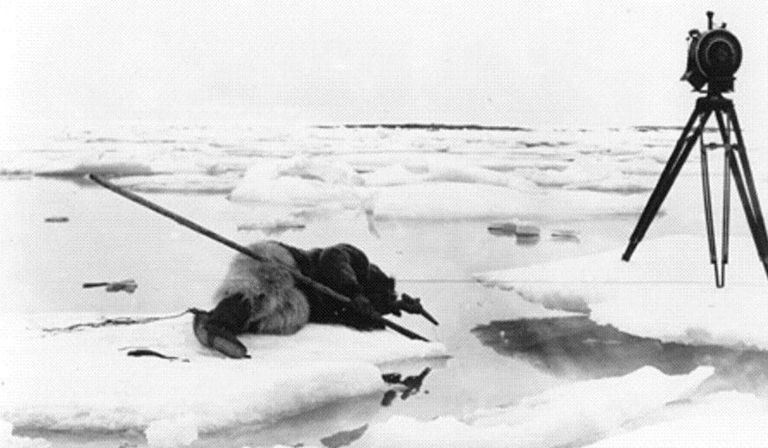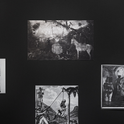In 1913, Robert Joseph Flaherty was a prospector in northern Canada, searching for iron ore on behalf of his employer, the railroad baron William Mackenzie. Flaherty’s expeditions to northwest Quebec were made possible by Inuit guides, and, over the course of his voyages, Flaherty became interested in documenting the Inuit way of life, which he saw as rapidly disappearing. He took a three-week camera-operating course from Eastman Kodak in Rochester, New York, and set off for the Hudson Bay with an early motion picture camera.
Four years, four expeditions and 30,000 feet of film later, Flaherty was assembling the footage from his journeys into a full-length film when stray cigarette ash ignited and destroyed his footage. No matter, Flaherty noted: “The editing print… was not burned and was shown several times... just long enough to make me realize it was no good.” He wanted better. So Flaherty spent more than a year on the Ungava Peninsula in northern Quebec with members of an Inuit community, creating a coherent cinematic narrative centred on a single figure, the brave hunter Nanook.
The resulting film, Nanook of the North, was released to acclaim in 1922, and is widely seen as the primogenitor of the contemporary documentary film. But the story of Nanook is complex, and the controversies it raises around authorship, representation, respect and ownership anticipate a modern set of questions associated with documentary film—and, indeed, with many types of creation.
The featured hunter was not named Nanook, but Allakariallak, which Flaherty feared audiences would not be able to pronounce. The women and children playing Nanook’s family were not actually his family, while everyone in the film wears traditional costumes that had long gone out of common usage. Allakariallak was an accomplished hunter, but generally hunted with a rifle, rather than the harpoon he uses in the film. Scenes within the film were clearly staged, particularly a memorable sequence about building an igloo, where “Nanook” and his “family” build a structure almost twice as large as usual, so that Flaherty and his camera could fit inside.
The success of Nanook at the box office brought Flaherty to Hollywood, where he and his wife, Frances Hubbard, received a contract from Paramount to produce Moana, a story of a young boy’s journey into manhood in Samoa. Flaherty ultimately produced six full-length films, all ethnographic studies of geographically isolated people.
Allakariallak’s cinematic career was much briefer. Two years after the film was released, he died of tuberculosis. The promoters of the film claimed that Allakariallak had died of starvation during a deer hunt, emphasising the dangers that “Nanook” and his family routinely braved. The organisation founded in Flaherty’s memory, the Flaherty Film Seminar, now describes Nanook of the North as “a work that history has recognized as the first documentary film, a cornerstone of ethnographic cinema, a modern art masterpiece, a racist fantasy, and an indefensible work of indigenous appropriation.”
However, there’s another way to tell the story of Allakariallak and Nanook; one that emphasises an important aspect of Flaherty’s process. During filming, Flaherty brought not only cameras, but also developing equipment and a projector. Each day, he shared the footage with his Inuit cast and crew, who made suggestions to increase the authenticity of film, many of which were included in the finished process. The methods that allowed Flaherty to produce a film in the high Arctic were the same that he used in later work—a collaboration with his subjects and his crew to co-create documentary narratives of everyday life, made primarily by an indigenous crew, but with an outside director.
Flaherty and Nanook are mentioned only once in Collective Wisdom, an exploration of co-creation primarily authored by filmmaker Katerina Cizek and media scholar William Uricchio. (In the spirit of co-creation, 11 individuals and the media collective Detroit Narrative Agency are also credited as authors.) But the questions raised by Nanook—Who has the right to tell someone’s story? How can we create narratives that are collaborative rather than exploitative?—run through this book and prove as challenging to consider in relation to contemporary creations as they are when analysing Flaherty’s work.
Is co-creation too unwieldy to be practical for most creators? Or is it actually so commonplace that it’s not worth special notice?
Cizek is an acclaimed documentarian whose best-known works have been created in cooperation with their subjects. Highrise, an examination of vertical living in cities around the world, is credited in part to “the residents of the high-rises at 2667 and 2677 Kipling Avenue in Toronto, Canada” (who are thanked, along with many others, in the acknowledgements of Collective Wisdom). Uricchio is a media scholar at MIT and Utrecht University, author of books on the history of media technologies and the evolution of cultural figures in cinema and entertainment. Along with MIT scholar Sara Wolozin, Cizek and Uricchio are founders of MIT’s Co-Creation Studio, which “researches and incubates collective creation as alternatives to singular authorship”. Wolozin’s contributions permeate Collective Wisdom to the extent that perhaps the studio itself should be considered the “author” here.
Co-creation is a conscious rejection of the myth of the author as creative genius. The authors trace that myth back to Romantic-era artists such as Rembrandt, Rubens and Rodin, whose output was the result of teams of unnamed assistants, as well as to businessmen such as Steve Jobs and Thomas Edison, whose “genius” similarly overshadowed those who did most of the work beneath them. In its place, Collective Wisdom seeks a new set of exemplars, from the collectively produced quilts of Gee’s Bend, Alabama, to the international collaboration that helped bring about vaccines and other public health solutions in response to Covid-19.
Perhaps the clearest definition of the term “co-creation” comes near the end of the book, in an interview with Cara Mertes, a funder at the Ford Foundation of co-creation projects: “Co-creation is a concept that covers a broad set of practices, which revolve around equity, dignity and justice.” If that definition seems broad or vague, it is intentionally so. Co-creation is an emerging practice, and the authors are less concerned with enforcing a strict definition of its boundaries than exploring the possibilities of a co-creative approach in a range of fields.
The book is rich—if occasionally overfull—with examples, including an index of works that help illustrate the principles of co-creation. Nanook is listed here as an early, influential and problematic example, alongside more than a hundred other entries; from journalistic collaborations such as the Panama Papers to virtual reality installations; from web-based projects of community self-documentation to an MIT hackathon dedicated to reinventing the breast pump. There’s so much here that you, as reader, feel a need for some canonical texts to help anchor the concept of co-creation—and a canon of sorts does indeed emerge in Collective Wisdom through the repetition of key examples.
Cizek’s films—notably, Highrise and Filmmaker-in-Residence, a five-year partnership in which the filmmaker worked with doctors, nurses and other stakeholders at an inner-city Toronto hospital—offer models for processes that can smooth the rough edges of co-creation. Collaborations between the hospital participants and filmmakers were passed through the hospital’s ethics board before being carried out. Participants co-authored a manifesto about the goals of the project and created painstaking contracts recognising the complexities around consent from patients taking part in a documentary.
Films produced by indigenous Canadian communities offer another structure for community partnership. In contrast to Flaherty’s collaboration almost a century earlier, SGaaway K’unna (The Edge of the Knife), a 2018 feature film shot in the Haida language, was co-created by the Haida Nation, an Inuit film production company and a non-indigenous professor at the University of British Columbia. The intellectual property of the film is owned entirely by the Haida Nation, who had power to hire and fire anyone on the project.
While co-creation has significant roots within the documentary film community, and the issues raised around ownership and authorship in that space, the authors of Collective Wisdom want to extend the principles of co-creation into additional fields and practices. Some of these examples can feel like overreach. While journalism clearly involves telling other people’s stories, the often-confrontational nature of investigation has made co-creative approaches challenging. Worse still, the book’s ethical investigations into artists collaborating with termites to produce mounds of crystals and coloured sand threaten to stretch its conceptual frame to breaking point.
However, the authors’ discussions of AI as a process of co-creation are more promising. Conversational AIs, such as ChatGPT, and AI image generators, such as Stable Diffusion, create new works from millions of other works by thousands of unnamed, unknowing collaborators. Stephanie Dinkins, a New York artist, collaborates with a humanoid robot, Bina48, created in 2007 on the “template” of an African-American woman, Bina Aspen Rothblatt. The resultant Conversations with Bina48, presented as a set of videotaped interviews, intentionally complicate the idea that an AI can be trained on the memories and behaviours of a black woman without incorporating the assumptions of the white, male programmers. The co-creation Dinkins engages in is investigative, critical and adversarial, and suggests ways in which this method can be confrontational, not just kumbaya.
The tensions embodied in Collective Wisdom come to the surface in a series of interviews that are mostly transcribed from events convened by the MIT Co-Creation Studio. A conversation with five media-makers of colour includes pointed questions about whether co-creation isn’t merely a traditional form of creativity, repackaged to seek grant funding. “Is it simply a way to legitimize a space for dominant culture to continue to be involved in telling our stories, a way of keeping some White control and presence over narratives by and about communities of color?” asks Haitian filmmaker Michèle Stephenson.
Other debates focus on the practicality of co-creation as a working method. Is it too complex and unwieldy to be practical for most creators? Or is it actually so commonplace a working method that it’s not worth special notice?
The authors see co-creation as aspirational, a set of processes and principles that can be applied with different levels of intensity in different projects. In that spirit, Collective Wisdom tries to offer several roadmaps for implementing co-creation in your own projects, but these roadmaps can be hard to follow, in part due to the book’s unusual structure. Chapters are punctuated with case studies, interviews, photo essays, diagrams and illustrations. At best, these turn the book into a hypertext, where you can be drawn into chapters of artistic or activist history by following an intriguing caption. At worst, they lead to confusion, when an apparently straightforward set of lessons is interrupted by a long soliloquy on the founding of a particular media centre.
In the end, there’s a strange sort of irony to the book. The case studies and interviews that break up the chapters allow Collective Wisdom to be the creation of a large team of co-authors, yet they also make it clear that a possible compromise in the co-creative process is trading a highly polished narrative for a fragmentary, sometimes confusing assemblage of multiple perspectives.
Where Collective Wisdom shines is in raising—and partially answering—some of the most challenging questions of authorship, credit and shared creativity in film and other creative fields. Is there an ethical way for a non-indigenous filmmaker to make a documentary about the Inuit, as Flaherty tried in 1922? This book offers some models, from the Haida Nation’s partnership with Canadian academics to the West Baffin Co-op, which has produced and distributed Inuit art since 1959. More important, though, is the simple hope that it finds within co-creation: the idea that a better way to treat each other as collaborators is not only possible, but essential.
















